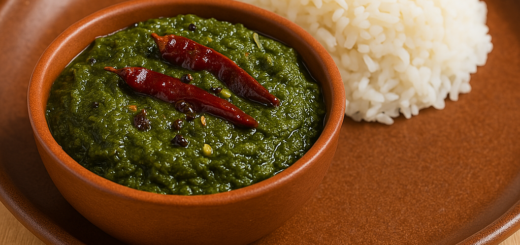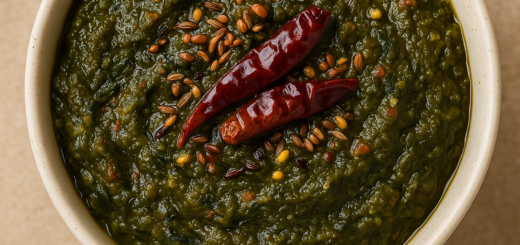Gongura Pachadi Recipe Without Coconut: A Traditional Andhra Telugu Brahmin Style
Learn how to make Gongura Pachadi in the traditional Andhra Telugu Brahmin style without coconut. A tangy, flavorful chutney perfect with rice and ghee!
Gongura Pachadi Recipe Without Coconut: A Traditional Andhra Telugu Brahmin Style
Gongura Pachadi, an iconic dish from Andhra Pradesh, is a tangy and spicy chutney made from Gongura (sorrel) leaves. This chutney is a staple in many Telugu Brahmin households and is typically enjoyed with rice, ghee, or even other South Indian dishes like dosa or idli. While traditional Gongura Pachadi often includes coconut, this version skips the coconut, letting the natural tartness of the Gongura leaves shine through. Whether you are a seasoned cook or a beginner, this simple recipe will bring the authentic taste of Andhra cuisine straight to your table.
Origin and History of Gongura Pachadi
Gongura, known as sorrel leaves in English, is widely used in Andhra cuisine. It has been a part of the region’s culinary heritage for generations, especially in Telugu Brahmin families. The tangy flavor of Gongura makes it a popular ingredient in chutneys, dals, and curries. The tradition of making Gongura Pachadi has been passed down through the ages, with each family adding their own twist to the recipe. In Telugu Brahmin households, Gongura Pachadi is a symbol of simplicity and flavor, often made during festivals or special occasions.
Cultural and Culinary Importance
In Andhra cuisine, Gongura Pachadi is more than just a chutney; it’s an essential part of the culture. It’s often made in large batches to serve during family meals or social gatherings. Gongura leaves are known for their numerous health benefits, including high vitamin C content and digestive properties. They are also cooling for the body, making Gongura Pachadi an ideal dish for the hot Andhra summers. For Telugu Brahmins, preparing this chutney without coconut highlights the traditional, pure flavors of Gongura, making it a cherished recipe passed from one generation to the next.
Ingredients Needed for Gongura Pachadi Without Coconut
| Ingredient | Quantity |
|---|---|
| Gongura leaves (fresh) | 1 bunch |
| Green chilies | 3-4 |
| Garlic cloves | 4-5 |
| Red chilies | 2-3 |
| Tamarind (small ball) | 1 |
| Salt | To taste |
| Oil (preferably sesame oil) | 1 tablespoon |
| Cumin seeds | 1 teaspoon |
| Mustard seeds | 1 teaspoon |
| Fenugreek seeds (optional) | 1/4 teaspoon |
| Hing (asafoetida) | A pinch |
Estimated Cost of the Complete Recipe in INR
The estimated cost for making Gongura Pachadi without coconut is approximately Rs. 50-70, depending on the local market rates for the ingredients.
Utensils Needed
| Utensil | Quantity |
|---|---|
| Pan or Tava | 1 |
| Mixing bowl | 1 |
| Mortar and Pestle or Mixer | 1 |
| Stirring spoon | 1 |
Cooking Temperature Details
The Gongura leaves should be cooked on medium heat to ensure they soften without burning. The tempering spices should be cooked on low heat to avoid overbrowning.
Nutritional Information
- Calories: ~40-50 kcal per serving
- Carbohydrates: ~8g
- Protein: ~1g
- Fat: ~2g
- Fiber: ~2g
- Vitamin C: High (from Gongura leaves)
- Iron: Present (from Gongura and tamarind)
Cooking and Preparation Time
| Activity | Time |
|---|---|
| Preparation time | 10 mins |
| Cooking time | 15-20 mins |
| Total time | 25-30 mins |
Step-by-Step Cooking Procedure
- Wash the Gongura leaves: Start by thoroughly washing the Gongura leaves under running water to remove any dirt or dust. Separate the leaves from the stems, as the stems can be tough and fibrous.
- Cook Gongura leaves: In a pan, heat a teaspoon of oil and add the Gongura leaves. Cook them on medium heat for about 5-7 minutes until they wilt and become soft. Stir occasionally to prevent burning.
- Prepare the tempering: In another pan, heat a tablespoon of oil. Once the oil is hot, add mustard seeds, cumin seeds, and fenugreek seeds (if using). Let them splutter for a few seconds before adding a pinch of hing (asafoetida).
- Roast the spices: Add red chilies and green chilies to the pan with the tempering and roast for 1-2 minutes. This step releases the aroma of the spices and infuses the oil with flavor.
- Grind the ingredients: Once the Gongura leaves have cooled down a bit, transfer them to a mixing bowl or grinder. Add the roasted spices, garlic cloves, tamarind, and salt. Blend everything into a coarse paste. If you prefer a smoother chutney, you can add a little water while grinding.
- Mix the tempering with the chutney: Add the ground Gongura paste to the pan with the tempering. Stir it well and cook for an additional 2-3 minutes on low flame to let the flavors meld together.
- Serve: Your Gongura Pachadi is ready! Serve it with hot rice and a dollop of ghee or as an accompaniment to dosas, idlis, or chapatis.
Tips for Cooking and Enhancing Flavors
- Adjust spice levels: If you prefer a milder chutney, reduce the number of green and red chilies.
- Freshness of Gongura: The freshness of the Gongura leaves enhances the taste of the pachadi. Always use tender, fresh leaves.
- Tamarind balance: Ensure that the tamarind is not too sour to avoid overpowering the chutney’s flavor.
- Consistency: For a thicker chutney, avoid adding water while grinding the ingredients.
Serving Procedure and Decoration Ideas
Serve the Gongura Pachadi as a side dish with steamed rice and ghee for the ultimate comfort food experience. It also pairs wonderfully with crispy dosas or soft idlis. Garnish with finely chopped coriander leaves for an added touch of freshness.
Best Food Combinations
- Best Combinations: Rice with ghee, chapati, dosa, idli, or curd rice.
- Foods to Avoid: Avoid pairing this chutney with overly rich or creamy dishes, as the tartness of Gongura can overwhelm such flavors.
Eating Process Explanation for Best Experience
The best way to enjoy Gongura Pachadi is by mixing it with steaming hot rice and ghee. The tangy chutney, combined with the richness of ghee, creates a satisfying meal. For an enhanced experience, eat it with crispy dosas or soft idlis for a perfect combination of textures and flavors.
Health Tips, Benefits, and Warnings
- Benefits: Gongura leaves are rich in vitamins A and C and are excellent for digestion. They also have anti-inflammatory properties and are known to cool the body during hot weather.
- Warning: People with sensitive stomachs or those prone to acidity should consume Gongura Pachadi in moderation due to its sourness.
Storage Instructions for Leftovers
Store leftover Gongura Pachadi in an airtight container in the refrigerator for up to 3 days. The chutney can be reheated before serving. If you have made a large batch, it can also be frozen for up to a month.
Things to Know
- Gongura leaves are a seasonal ingredient, so it’s best to make Gongura Pachadi when fresh leaves are available.
- You can experiment by adding roasted peanuts or sesame seeds for a different flavor profile.
- Gongura is known for its health benefits, such as improving digestion and acting as a cooling agent for the body.
FAQ Section
- Can I use dried Gongura leaves for this recipe?
- Fresh Gongura leaves are preferred, but if dried leaves are used, soak them in water for a few hours to rehydrate them before preparing the chutney.
- How long can I store Gongura Pachadi?
- You can store the chutney in the fridge for 2-3 days. For longer storage, freezing is an option.
- Can I make this without tamarind?
- While tamarind adds a tangy flavor, you can skip it if you prefer a milder chutney. You can add a bit of lemon juice for acidity instead.
By following this traditional Andhra Telugu Brahmin recipe for Gongura Pachadi, you can enjoy the authentic taste of Andhra cuisine without the coconut, highlighting the vibrant flavors of Gongura leaves. Enjoy this tangy chutney with your meals for a delightful culinary experience!


